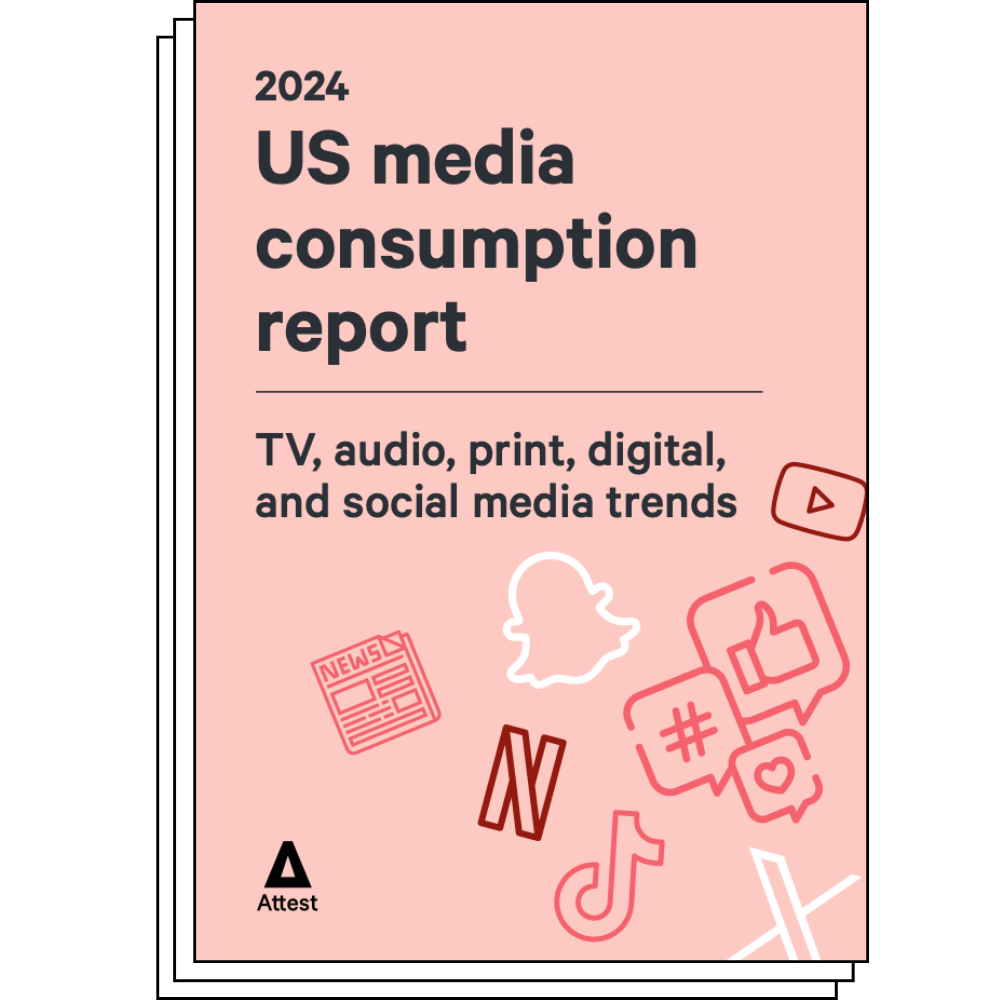Understanding US Gen Z media consumption trends: Insights for brands

As digital natives, Generation Z have grown up immersed in the internet, mobile technology, and social media. How does this impact their spending power and buying decisions?
Their approach to media consumption is unique, marked by preferences for interactivity, personalization, and authenticity. Brands and content creators aiming to capture Gen Z’s attention need to understand these nuances and evolve accordingly.
To better understand what influences their media consumption choices, we surveyed 1,000 Gen Zers in the US aged 21 to 27 using Attest’s platform to provide relevant insights on these trends.
The survey data provides a comprehensive look into Generation Z’s media consumption habits, preferences for immersive content, and attitudes toward interactive digital experiences. Here’s an overview of the trends based on the survey findings.
Quick summary
- 72.9% of Gen Z spends over an hour on paid subscription services like Netflix and Hulu.
- 81% of Gen Z spends 1+ hour daily on social media, with over half using it for 3+ hours.
- 67% of Gen Z prefers comedy and memes on short-form content platforms like TikTok.
- 42.9% rely on social media for daily news, with TikTok leading for 21% of users.
- 47% of Gen Z engages with AR/VR experiences, viewing them as integral to digital life.
What are the top Gen Z media consumption trends for 2025?
On-demand and short-form content: flexibility and speed
Gen Z has grown up with the ability to access content instantly, across a range of digital platforms, so they expect media that’s fast, accessible, and tailored to their schedules – more so than older generations.
This is evident when looking at what form of media they typically engage, with close to 1 in 3 saying they never watch linear tv or traditional TV and the majority (72.9%) spending more than an hour watching a paid for subscription service and streaming services (such as Netflix).
This highlights a clear preference for subscription-based services, which offer convenience and personalised viewing experiences.

As a result, on-demand streaming platforms such as Netflix, Hulu, and Disney+ are far more appealing in terms of media they are willing to pay for, with a majority 4 in 5 (82%) willing to pay for these services.
Streaming music services also capture significant interest, with 2 in 3 (67.6%) of Gen Z subscribers indicating a willingness to pay. However, less than 16% are interested in news, magazine subscriptions, or e-books, demonstrating that traditional and text-heavy media content holds limited appeal.
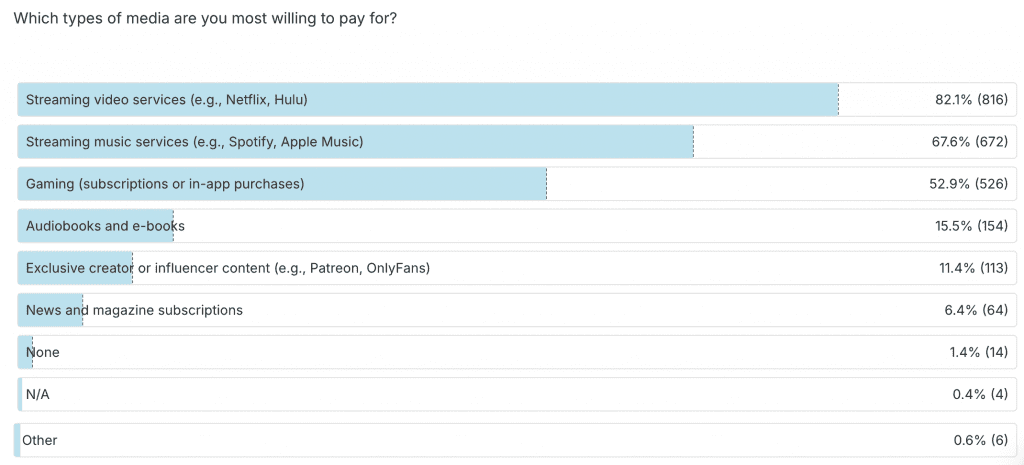
Social media usage and engagement
Gen Z is immersed in tons of social media platforms and platforms across the digital world. And it’s no surprise that a whopping 81% of respondents spend 1 hour or more per day on social platforms.
Over half of total respondents spend 3+ hours on social media per day, and we’ve found that females are statistically more likely to be in this super user cohort as compared to males.
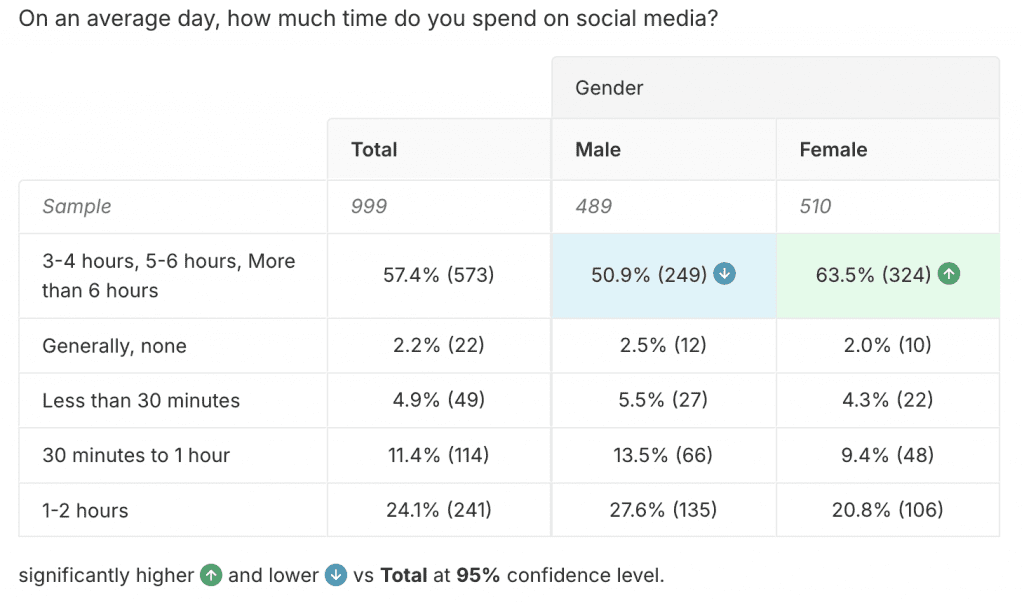
All this time Gen Z users spend online is interestingly filled with a gravitation towards watching content that’s short-form, especially on platforms like TikTok, Instagram Reels, and YouTube Shorts, where video clips range from a few seconds to a few minutes.
The appeal of these formats lies in their brevity, which aligns with Gen Z media habits and preference for quick, impactful snippets that fit easily into their busy, multitasking lifestyles. The types of short form content enjoyed varies, with over 67% of respondents preferring comedy and memes, 44% watching educational or “how-to” content, and 40% consuming personal stories and vlogs.
Females tend to like more personal content. Brands leveraging these platforms are learning that content needs to be both short and highly engaging to make an impact.
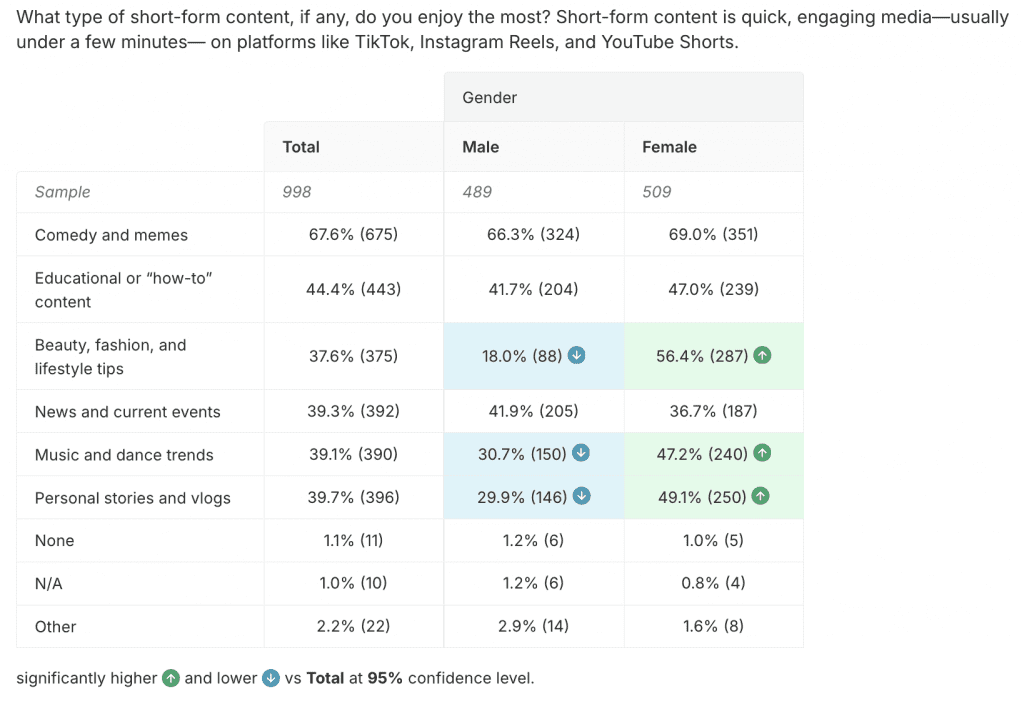
Social media: the new newspaper
Social media isn’t just for entertainment; it’s also a primary news source for Gen Z. In contrast to the previous generation, more than 2 in 5 (42.9%) get their news daily from social media platforms and only 5.1% saying that they never get their news from these sources. This echoes what we saw earlier as Gen Zers tend towards digital platforms over older mediums like traditional tv.
In terms of platforms they rely on most for their news, Tiktok remains the most popular with 1 in 5 (21%) followed by YouTube and news apps.
Looking closer there is a difference across the genders with males more inclined to use YouTube for news and less inclined to use TikTok or Facebook. While women are more inclined to use TikTok.
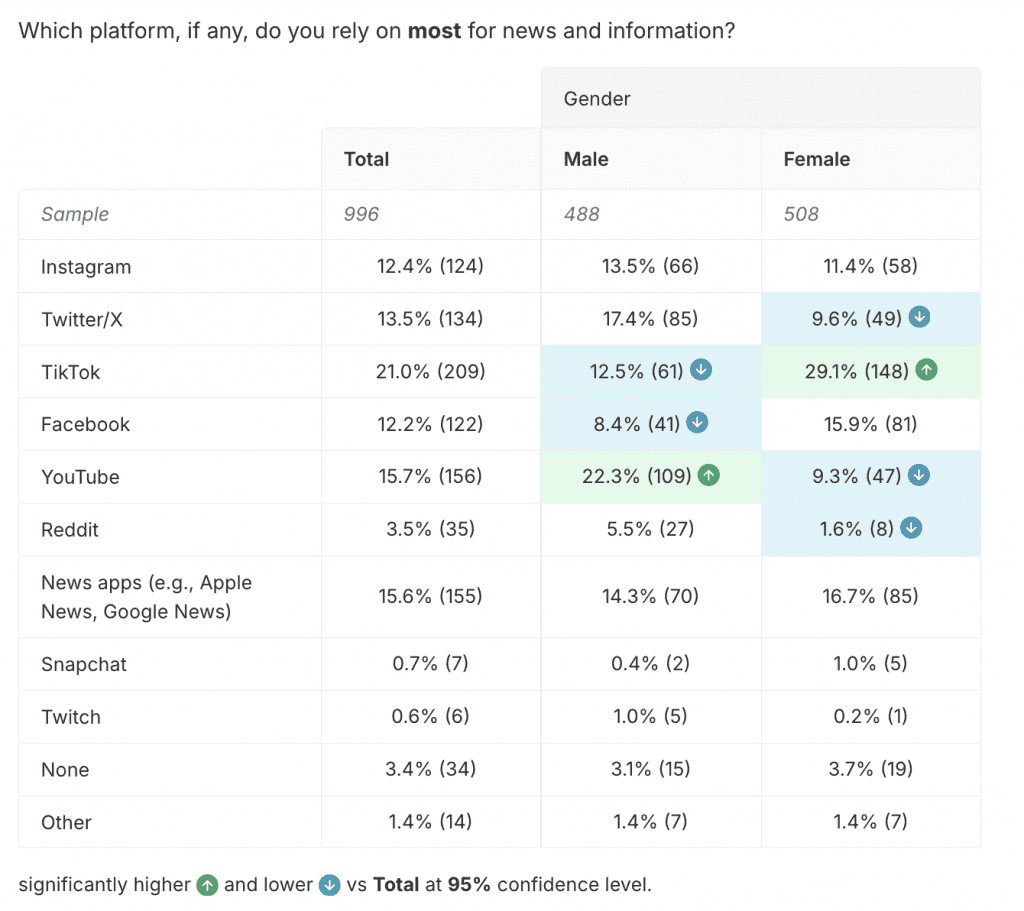
Embracing immersive experiences: Augmented Reality (AR) and Virtual Reality (VR)
Gen Z’ has a strong engagement and interest in immersive technologies like AR and VR, with over 47% of respondents engaging in these experiences.
Unlike previous generations who might view AR and VR as novelties, Gen Z shoppers see these technologies as natural extensions of digital interaction. AR filters on platforms like Snapchat and Instagram have become popular because they are simple, accessible, and allow for creativity.
Generation Z is excited by experiences that bring digital content closer to the real world and over half are willing to pay for enhanced or immersive content experiences.
For brands and creators, this trend signals an opportunity to create AR and VR experiences that enhance engagement to reach Gen Z. Whether it’s through VR events or AR filters in apps, these immersive experiences can help capture Gen Z’s attention and loyalty.
The power of interactivity: livestreams, polls and personalized engagement
Gen Z doesn’t just use social media as a content consumption tool—it’s a platform for building communities.
Gen Z values two-way communication and thrives on interactivity. Interactive elements—like polls, quizzes, and Q&A sessions—have become essential parts of their media experience for over 43% of respondents. Platforms like Instagram, TikTok, and YouTube allow for direct interaction with creators and brands, which appeals to Gen Z’s desire for authenticity and real-time connection.
Livestreams, particularly those with interactive features (like chat functions or live polls), have gained popularity among Gen Z with over 30% of respondents engaging with this type of content, with men overindexing on using these. Brands that want to reach Gen Z effectively should consider how they can use live content to foster interaction, whether through hosting events, product launches or exclusive Q&A sessions.
Another intriguing aspect of Gen Z consumer behavior is the interest in choose-your-own-adventure (CYOA) style content which has over a third of the survey respondents engaging in. These experiences offer a sense of control, allowing viewers to direct the outcome of a story or choose different narrative paths. This interactivity taps into Gen Z’s preference for personalised experiences and their desire for agency over what they consume.

Free content with a taste for premium: openness to paid, high-quality content
While Gen Z values free content, with 32% preferring not paying for enhanced experiences, over 60% of respondents are potentially willing to pay for enhanced or immersive experiences if they perceive value.
This spending power and willingness to invest in premium content—particularly when it’s of high quality—signals a departure from older generations who may have been more resistant to paid content. For Gen Z, spending money on digital experiences is part of their overall media habit and willingness to build on that. We see that males are more willing to pay for this as well.
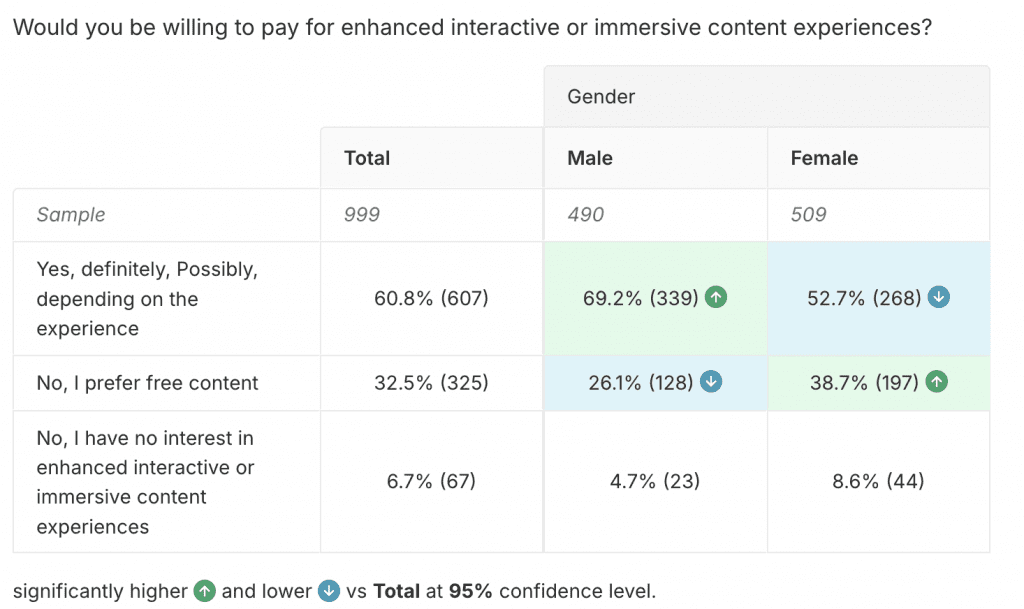
Subscription services, ad-free experiences, immersive content experiences, and exclusive content bundles can appeal to this generation, but only if they offer something different from the free alternatives. Brands that understand the balance between high-quality free content and premium offerings are likely to attract Gen Z consumers willing to pay for added value.
Skepticism toward AI-generated content
Interestingly, Gen Z is sceptical about AI-generated content, particularly when brands use it to replace human models or interactions.
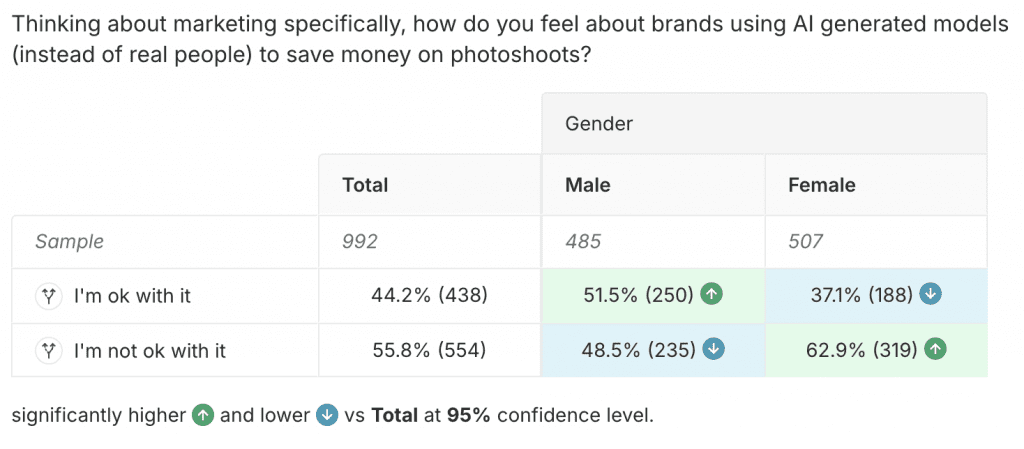
Over 55% of respondents are not okay with brands using AI generated models, with the top reasons being inauthenticity, the potential of being misleading, and the result of taking jobs from people. Women are significantly more likely to say that they are not okay with this practice.
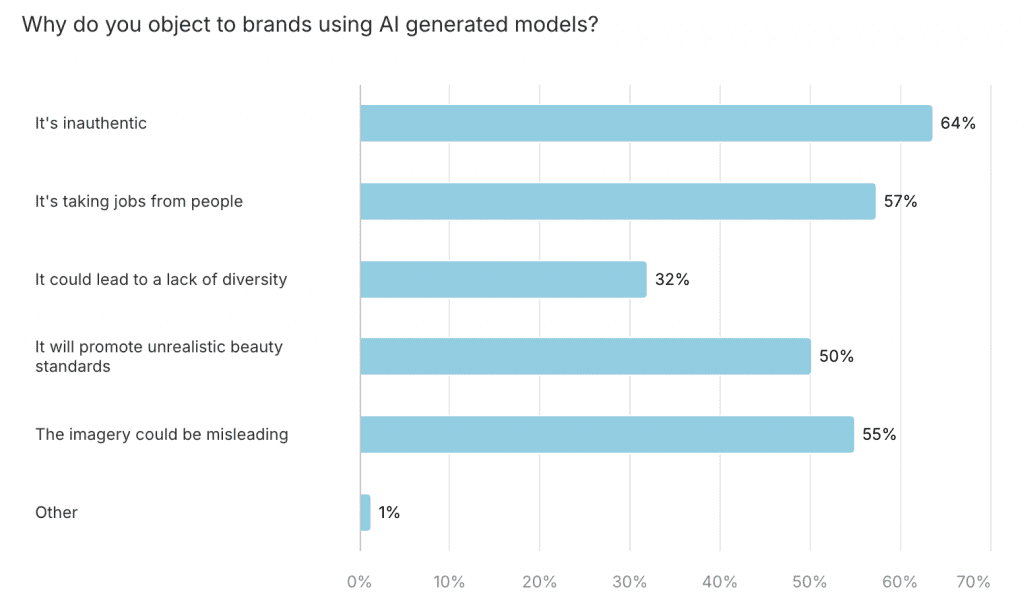
Unlike other generations like Millennials or Boomers who might see AI as futuristic and cool, Gen Z is more cautious, with a significant majority (63%) of respondents viewing it as potentially inauthentic. They are wary of content that feels unauthentic and untrustworthy, with more than 70% agreeing they worry about being able to trust what I see/hear because of AI. This emphasizes the importance of a human touch in brand communications.
To resonate with Gen Z, brands may want to tread carefully with AI-generated models and automated content, focusing instead on genuine interactions, relatable influencers, and personalized messages that feel more human.
How can brands adapt to Gen Z’s media habits?
Generation Z’s media consumption habits and behaviors emphasize the importance of creating engaging, interactive, and authentic experiences. As digital natives, they value convenience and personalized experiences but remain cautious about the authenticity and reliability of information.
Content creators and brands can take advantage of these trends by prioritizing platforms and features that emphasize authenticity and offering high-quality free and premium content, and maintaining a human element in their media strategy. Some key takeaways for reaching Gen Z include:
- Invest in short-form content across popular digital platforms.
- Incorporate interactive elements like polls, quizzes, and live chats to build real-time connections.
- Balance free and paid content, offering premium experiences that genuinely add value.
- Further understand perceptions of AI in content creation and understand how to tailor authentic content to your specific audience. Gen Z is worried about AI use and view it as untrustworthy, how can they be reassured when it is used in advertising or marketing
By aligning with Gen Z’s expectations and preferences, brands and creators can build lasting relationships with this influential generation and stay relevant in an ever-evolving digital landscape.
How can Attest help you understand your Gen Z audience?
Understanding how your Gen Z target customers interact with things like social media, digital content and everything else is key to making decisions that put your brand ahead of your competitors.
Getting to grips with how your target customers consume, think and buy lets you:
- Define your most valuable Gen Z customers
- Understand purchase barriers and drivers
- Find the right marketing channels
Attest gives you the platform you need to do all of this. Here’s some of what you can do with Attest to figure out how to win with your Gen Z customers:
- Compare customer segments side-by-side
- Keep your insights costs straightforward with flat audience costs
- Localize surveys for each of your markets.
- and more…
Research methodology
For this research we surveyed 1,000 adult Gen Zers in the US in the 21 to 27 age group using Attest’s platform. We ran this research around 4 November 2024.
Tell us what you think of this article by leaving a comment on LinkedIn.
Or share it on:

